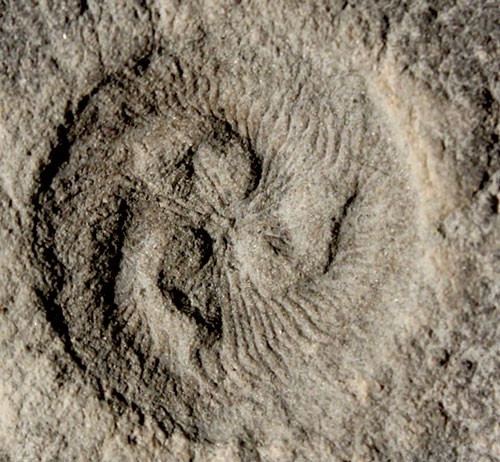This Ancient Three Armed Creature Looks Like Nothing Alive on Earth Today
| Ana Verayo | | Dec 01, 2015 06:40 AM EST |
(Photo : M. Laflamme/University of Bristol) Fossil of the extinct organism Tribrachidium
Scientists have uncovered the most bizarre ancient creature to date, as this animal does not look like anything alive on Earth today, where its distinct shape is most likely used to collect drifting particles underwater during feeding, according to a new study.
Like Us on Facebook
This primordial creature is known as the Tribrachidium that lived in shallow marine environments some 550 million years ago. The animal is also shaped like a disk with three tentacle like arms that are jutting out from its flat body.
The Tribrachidium oddly possesses a three fold symmetry, which means it has three segments that are mirror images of one another, where humans are two fold or bilateral and starfish have a five fold symmetry. Scientists note that nothing alive today has this three fold symmetry.
According to lead author of the study, Imran Rahman from the University of Bristol, since there is no existing comparison, this is really challenging to figure out how the organism was like when it was alive, its movements, its feeding patterns and diet including its reproduction process.
Using fluid dynamics, the team determined that the Tribrachidium was most likely a suspension feeder, which means it feeds on floating organic particles underwater. Today, suspension feeders include many crustaceans, bivalves and brittle stars.
This creature also existed some 40 million years prior to the Cambrian explosion, which is when life on Earth rapidly increased and diversified. These new findings provide a glimpse of how complex life was during this time and it's even possible that the Tribrachidium changed its environment.
Rahman explains suspension feeding as mobilizing organic material that are being carried around in the water column, increasing the passage of sunlight in the water and increasing oxygen as well.
To determine how the Tribrachidium fed, the team created a 3D digital model of the organism using a cast from a fossil recovered in southern Australia where they applied virtual currents that are found in shallow seafloors. The currents slowed down when they cross the Tribrachidium and form eddies that recirculate the waters back to the creature, into the nooks and crannies of its symmetrical arms.
This new study is published in the journal Science Advances.
Tagsancient three armed creature, Tribrachidium, animal evolution, suspension feeder, ancient organisms, three fold symmetry in animals, first ecosystems on earth
©2015 Chinatopix All rights reserved. Do not reproduce without permission
EDITOR'S PICKS
-

Did the Trump administration just announce plans for a trade war with ‘hostile’ China and Russia?
-

US Senate passes Taiwan travel bill slammed by China
-

As Yan Sihong’s family grieves, here are other Chinese students who went missing abroad. Some have never been found
-

Beijing blasts Western critics who ‘smear China’ with the term sharp power
-

China Envoy Seeks to Defuse Tensions With U.S. as a Trade War Brews
-

Singapore's Deputy PM Provides Bitcoin Vote of Confidence Amid China's Blanket Bans
-

China warns investors over risks in overseas virtual currency trading
-

Chinese government most trustworthy: survey
-

Kashima Antlers On Course For Back-To-Back Titles
MOST POPULAR
LATEST NEWS
Zhou Yongkang: China's Former Security Chief Sentenced to Life in Prison

China's former Chief of the Ministry of Public Security, Zhou Yongkang, has been given a life sentence after he was found guilty of abusing his office, bribery and deliberately ... Full Article
TRENDING STORY

China Pork Prices Expected to Stabilize As The Supplies Recover

Elephone P9000 Smartphone is now on Sale on Amazon India

There's a Big Chance Cliffhangers Won't Still Be Resolved When Grey's Anatomy Season 13 Returns

Supreme Court Ruled on Samsung vs Apple Dispute for Patent Infringement

Microsoft Surface Pro 5 Rumors and Release Date: What is the Latest?










